Report on Teacher Roles, Theorist Influence, and Classroom Environment
VerifiedAdded on 2023/06/10
|11
|2738
|473
Report
AI Summary
This report provides a comprehensive analysis of various aspects of teaching, including the roles fulfilled by teachers, the influence of learning theorists, and the importance of curriculum design. It delves into the seven roles of a teacher, emphasizing the significance of tutoring in motivating students. The report also explores how Vygotsky's sociocultural theory and Montessori's method of learning impact teaching approaches, focusing on accommodating diverse characteristics in the classroom and addressing poor literacy levels. Furthermore, it discusses the need for a well-defined curriculum, differentiates between formal and informal assessments, and outlines the seven principles of positive feedback. The report also examines the creation of a positive learning environment, suggesting improvements to stimulate creativity and critical thinking. Finally, it differentiates between reflection-in-action and reflection-on-action, advocating for differentiated instruction techniques and child-centered learning practices to overcome barriers to learning and promote effective teaching.
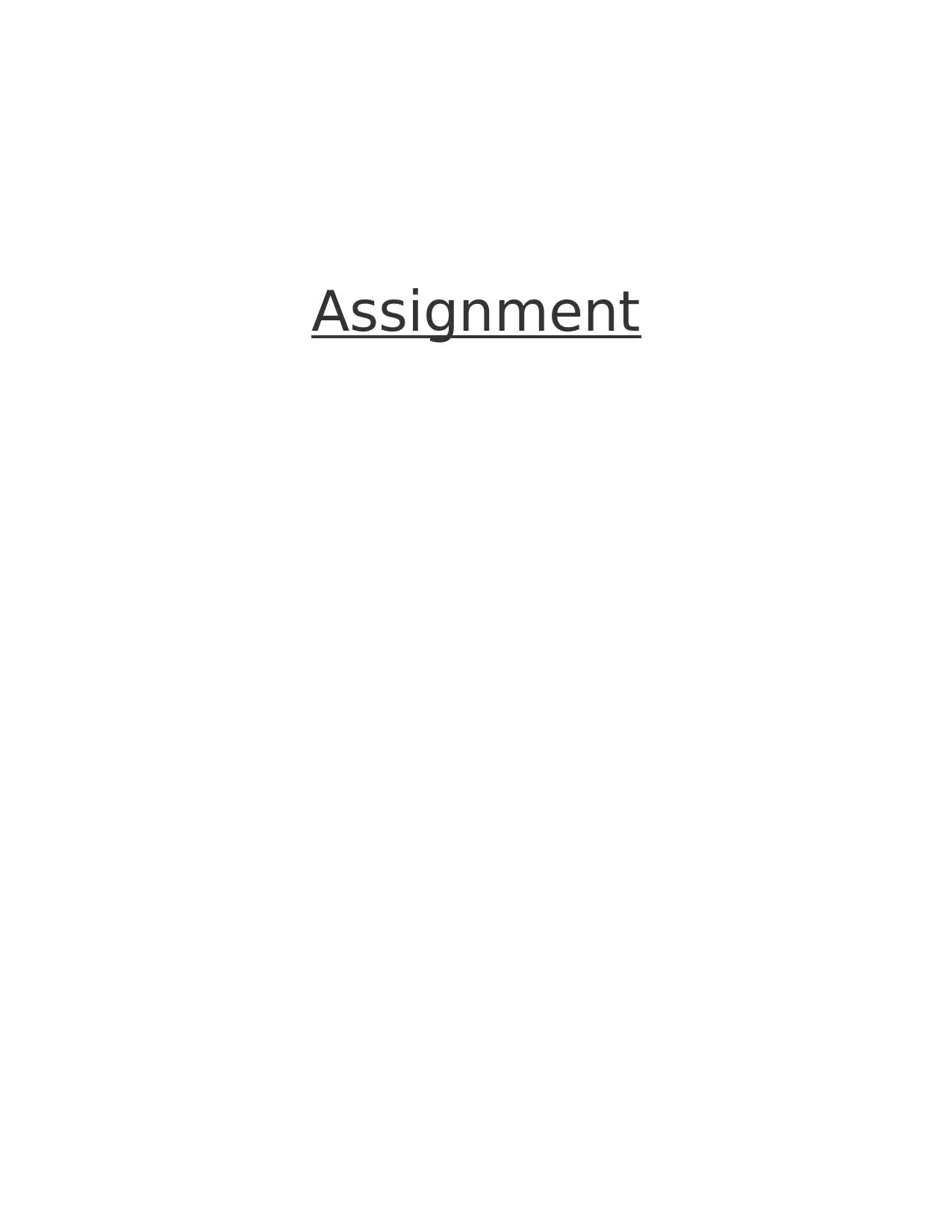
Assignment
Paraphrase This Document
Need a fresh take? Get an instant paraphrase of this document with our AI Paraphraser
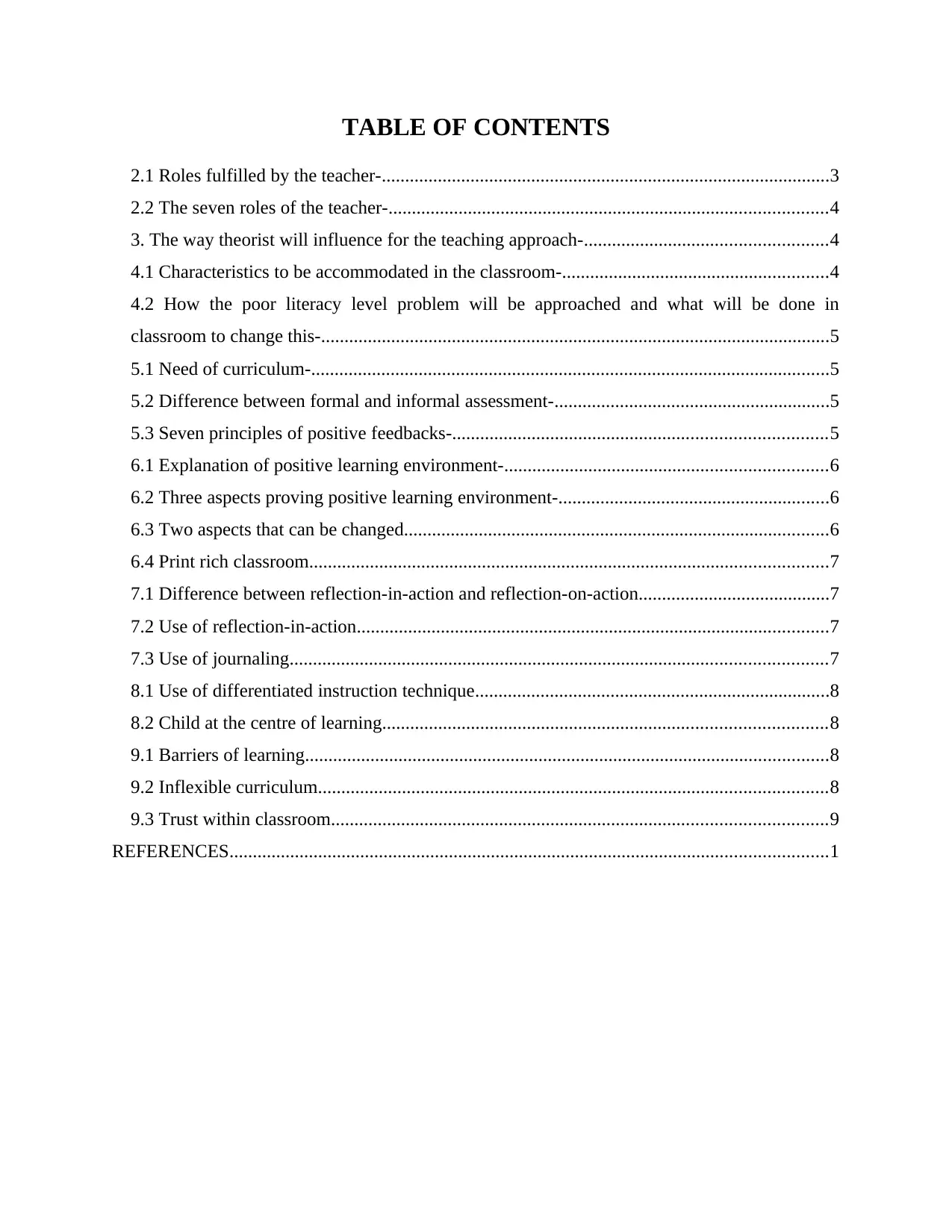
TABLE OF CONTENTS
2.1 Roles fulfilled by the teacher-................................................................................................3
2.2 The seven roles of the teacher-..............................................................................................4
3. The way theorist will influence for the teaching approach-....................................................4
4.1 Characteristics to be accommodated in the classroom-.........................................................4
4.2 How the poor literacy level problem will be approached and what will be done in
classroom to change this-.............................................................................................................5
5.1 Need of curriculum-...............................................................................................................5
5.2 Difference between formal and informal assessment-...........................................................5
5.3 Seven principles of positive feedbacks-................................................................................5
6.1 Explanation of positive learning environment-.....................................................................6
6.2 Three aspects proving positive learning environment-..........................................................6
6.3 Two aspects that can be changed...........................................................................................6
6.4 Print rich classroom...............................................................................................................7
7.1 Difference between reflection-in-action and reflection-on-action.........................................7
7.2 Use of reflection-in-action.....................................................................................................7
7.3 Use of journaling...................................................................................................................7
8.1 Use of differentiated instruction technique............................................................................8
8.2 Child at the centre of learning...............................................................................................8
9.1 Barriers of learning................................................................................................................8
9.2 Inflexible curriculum.............................................................................................................8
9.3 Trust within classroom..........................................................................................................9
REFERENCES................................................................................................................................1
2.1 Roles fulfilled by the teacher-................................................................................................3
2.2 The seven roles of the teacher-..............................................................................................4
3. The way theorist will influence for the teaching approach-....................................................4
4.1 Characteristics to be accommodated in the classroom-.........................................................4
4.2 How the poor literacy level problem will be approached and what will be done in
classroom to change this-.............................................................................................................5
5.1 Need of curriculum-...............................................................................................................5
5.2 Difference between formal and informal assessment-...........................................................5
5.3 Seven principles of positive feedbacks-................................................................................5
6.1 Explanation of positive learning environment-.....................................................................6
6.2 Three aspects proving positive learning environment-..........................................................6
6.3 Two aspects that can be changed...........................................................................................6
6.4 Print rich classroom...............................................................................................................7
7.1 Difference between reflection-in-action and reflection-on-action.........................................7
7.2 Use of reflection-in-action.....................................................................................................7
7.3 Use of journaling...................................................................................................................7
8.1 Use of differentiated instruction technique............................................................................8
8.2 Child at the centre of learning...............................................................................................8
9.1 Barriers of learning................................................................................................................8
9.2 Inflexible curriculum.............................................................................................................8
9.3 Trust within classroom..........................................................................................................9
REFERENCES................................................................................................................................1
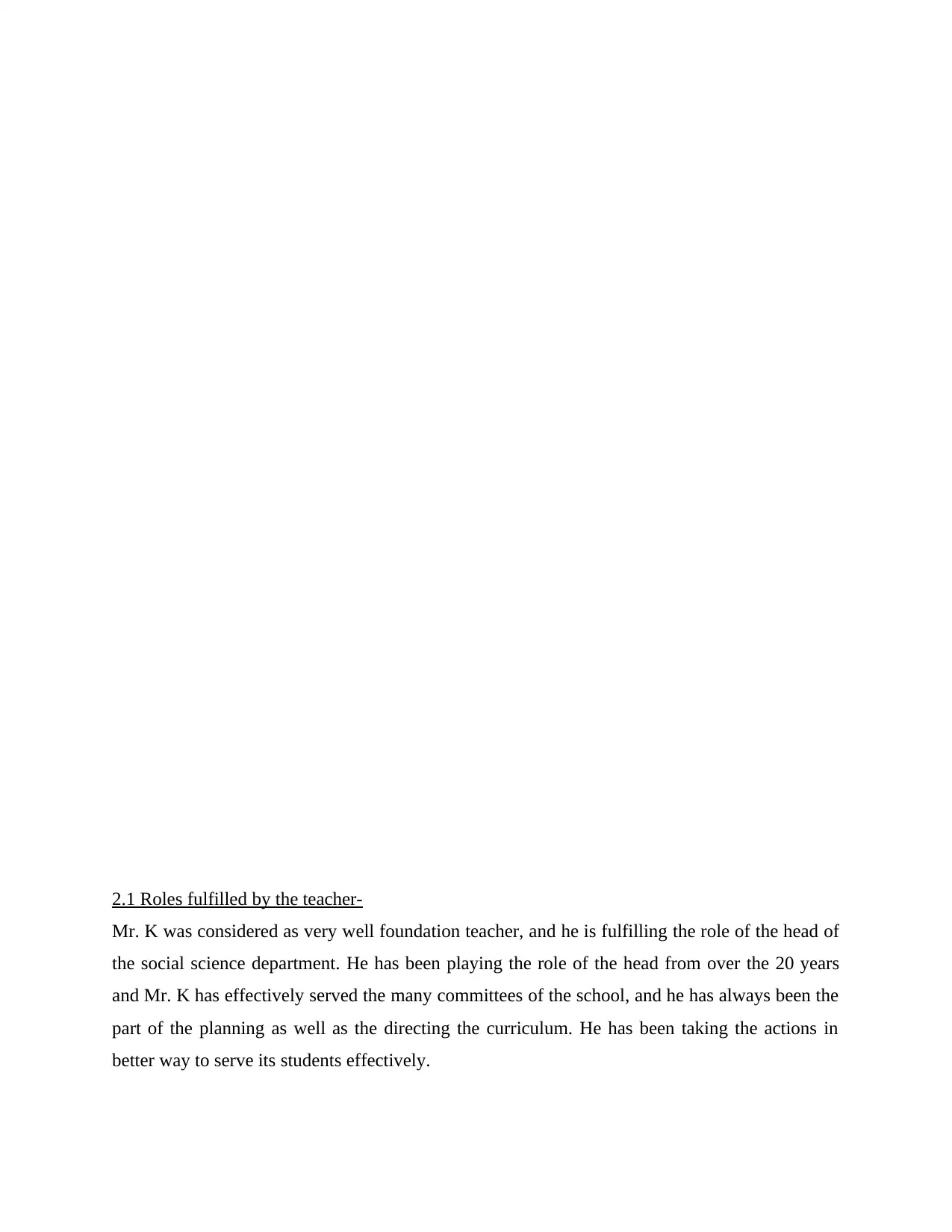
2.1 Roles fulfilled by the teacher-
Mr. K was considered as very well foundation teacher, and he is fulfilling the role of the head of
the social science department. He has been playing the role of the head from over the 20 years
and Mr. K has effectively served the many committees of the school, and he has always been the
part of the planning as well as the directing the curriculum. He has been taking the actions in
better way to serve its students effectively.
Mr. K was considered as very well foundation teacher, and he is fulfilling the role of the head of
the social science department. He has been playing the role of the head from over the 20 years
and Mr. K has effectively served the many committees of the school, and he has always been the
part of the planning as well as the directing the curriculum. He has been taking the actions in
better way to serve its students effectively.
⊘ This is a preview!⊘
Do you want full access?
Subscribe today to unlock all pages.

Trusted by 1+ million students worldwide
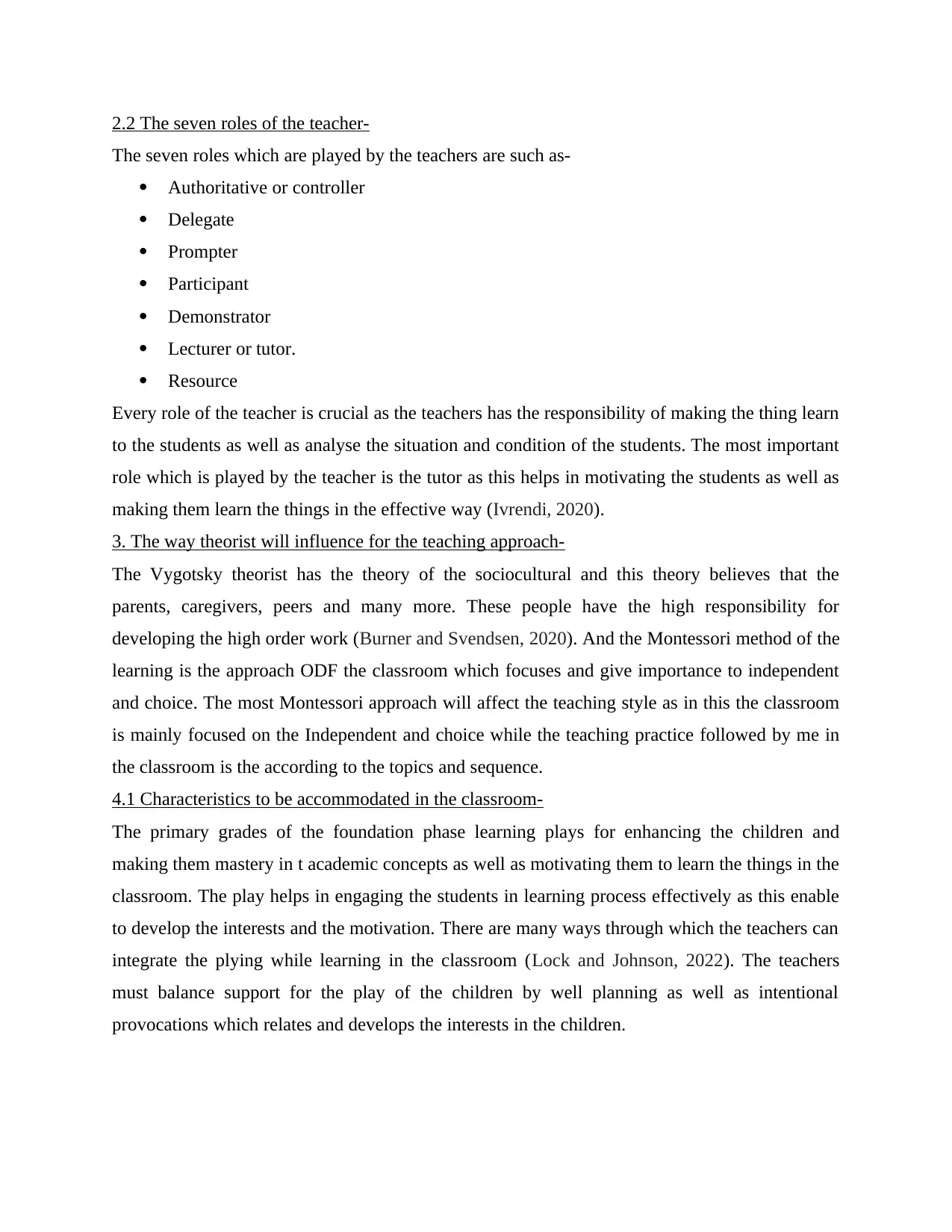
2.2 The seven roles of the teacher-
The seven roles which are played by the teachers are such as-
Authoritative or controller
Delegate
Prompter
Participant
Demonstrator
Lecturer or tutor.
Resource
Every role of the teacher is crucial as the teachers has the responsibility of making the thing learn
to the students as well as analyse the situation and condition of the students. The most important
role which is played by the teacher is the tutor as this helps in motivating the students as well as
making them learn the things in the effective way (Ivrendi, 2020).
3. The way theorist will influence for the teaching approach-
The Vygotsky theorist has the theory of the sociocultural and this theory believes that the
parents, caregivers, peers and many more. These people have the high responsibility for
developing the high order work (Burner and Svendsen, 2020). And the Montessori method of the
learning is the approach ODF the classroom which focuses and give importance to independent
and choice. The most Montessori approach will affect the teaching style as in this the classroom
is mainly focused on the Independent and choice while the teaching practice followed by me in
the classroom is the according to the topics and sequence.
4.1 Characteristics to be accommodated in the classroom-
The primary grades of the foundation phase learning plays for enhancing the children and
making them mastery in t academic concepts as well as motivating them to learn the things in the
classroom. The play helps in engaging the students in learning process effectively as this enable
to develop the interests and the motivation. There are many ways through which the teachers can
integrate the plying while learning in the classroom (Lock and Johnson, 2022). The teachers
must balance support for the play of the children by well planning as well as intentional
provocations which relates and develops the interests in the children.
The seven roles which are played by the teachers are such as-
Authoritative or controller
Delegate
Prompter
Participant
Demonstrator
Lecturer or tutor.
Resource
Every role of the teacher is crucial as the teachers has the responsibility of making the thing learn
to the students as well as analyse the situation and condition of the students. The most important
role which is played by the teacher is the tutor as this helps in motivating the students as well as
making them learn the things in the effective way (Ivrendi, 2020).
3. The way theorist will influence for the teaching approach-
The Vygotsky theorist has the theory of the sociocultural and this theory believes that the
parents, caregivers, peers and many more. These people have the high responsibility for
developing the high order work (Burner and Svendsen, 2020). And the Montessori method of the
learning is the approach ODF the classroom which focuses and give importance to independent
and choice. The most Montessori approach will affect the teaching style as in this the classroom
is mainly focused on the Independent and choice while the teaching practice followed by me in
the classroom is the according to the topics and sequence.
4.1 Characteristics to be accommodated in the classroom-
The primary grades of the foundation phase learning plays for enhancing the children and
making them mastery in t academic concepts as well as motivating them to learn the things in the
classroom. The play helps in engaging the students in learning process effectively as this enable
to develop the interests and the motivation. There are many ways through which the teachers can
integrate the plying while learning in the classroom (Lock and Johnson, 2022). The teachers
must balance support for the play of the children by well planning as well as intentional
provocations which relates and develops the interests in the children.
Paraphrase This Document
Need a fresh take? Get an instant paraphrase of this document with our AI Paraphraser
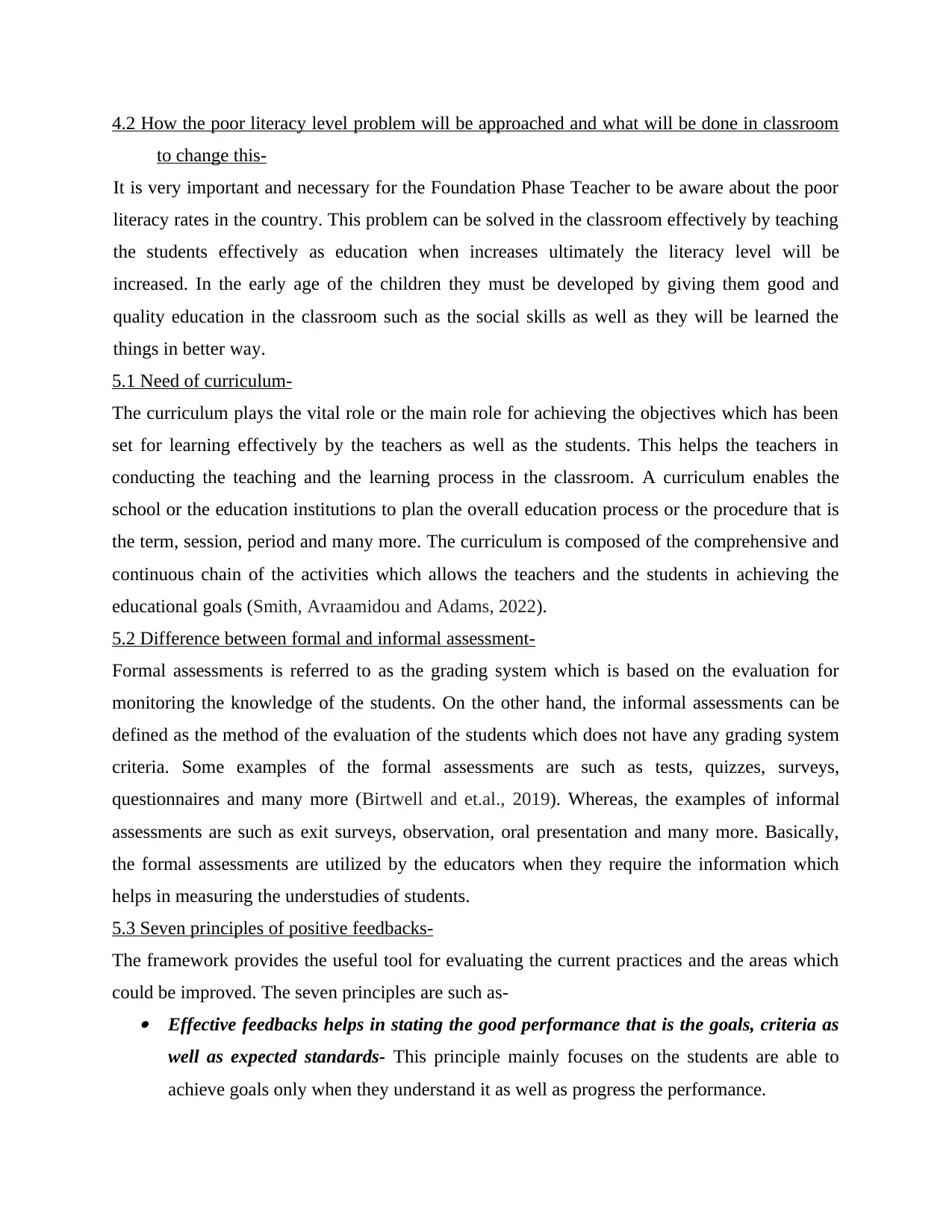
4.2 How the poor literacy level problem will be approached and what will be done in classroom
to change this-
It is very important and necessary for the Foundation Phase Teacher to be aware about the poor
literacy rates in the country. This problem can be solved in the classroom effectively by teaching
the students effectively as education when increases ultimately the literacy level will be
increased. In the early age of the children they must be developed by giving them good and
quality education in the classroom such as the social skills as well as they will be learned the
things in better way.
5.1 Need of curriculum-
The curriculum plays the vital role or the main role for achieving the objectives which has been
set for learning effectively by the teachers as well as the students. This helps the teachers in
conducting the teaching and the learning process in the classroom. A curriculum enables the
school or the education institutions to plan the overall education process or the procedure that is
the term, session, period and many more. The curriculum is composed of the comprehensive and
continuous chain of the activities which allows the teachers and the students in achieving the
educational goals (Smith, Avraamidou and Adams, 2022).
5.2 Difference between formal and informal assessment-
Formal assessments is referred to as the grading system which is based on the evaluation for
monitoring the knowledge of the students. On the other hand, the informal assessments can be
defined as the method of the evaluation of the students which does not have any grading system
criteria. Some examples of the formal assessments are such as tests, quizzes, surveys,
questionnaires and many more (Birtwell and et.al., 2019). Whereas, the examples of informal
assessments are such as exit surveys, observation, oral presentation and many more. Basically,
the formal assessments are utilized by the educators when they require the information which
helps in measuring the understudies of students.
5.3 Seven principles of positive feedbacks-
The framework provides the useful tool for evaluating the current practices and the areas which
could be improved. The seven principles are such as- Effective feedbacks helps in stating the good performance that is the goals, criteria as
well as expected standards- This principle mainly focuses on the students are able to
achieve goals only when they understand it as well as progress the performance.
to change this-
It is very important and necessary for the Foundation Phase Teacher to be aware about the poor
literacy rates in the country. This problem can be solved in the classroom effectively by teaching
the students effectively as education when increases ultimately the literacy level will be
increased. In the early age of the children they must be developed by giving them good and
quality education in the classroom such as the social skills as well as they will be learned the
things in better way.
5.1 Need of curriculum-
The curriculum plays the vital role or the main role for achieving the objectives which has been
set for learning effectively by the teachers as well as the students. This helps the teachers in
conducting the teaching and the learning process in the classroom. A curriculum enables the
school or the education institutions to plan the overall education process or the procedure that is
the term, session, period and many more. The curriculum is composed of the comprehensive and
continuous chain of the activities which allows the teachers and the students in achieving the
educational goals (Smith, Avraamidou and Adams, 2022).
5.2 Difference between formal and informal assessment-
Formal assessments is referred to as the grading system which is based on the evaluation for
monitoring the knowledge of the students. On the other hand, the informal assessments can be
defined as the method of the evaluation of the students which does not have any grading system
criteria. Some examples of the formal assessments are such as tests, quizzes, surveys,
questionnaires and many more (Birtwell and et.al., 2019). Whereas, the examples of informal
assessments are such as exit surveys, observation, oral presentation and many more. Basically,
the formal assessments are utilized by the educators when they require the information which
helps in measuring the understudies of students.
5.3 Seven principles of positive feedbacks-
The framework provides the useful tool for evaluating the current practices and the areas which
could be improved. The seven principles are such as- Effective feedbacks helps in stating the good performance that is the goals, criteria as
well as expected standards- This principle mainly focuses on the students are able to
achieve goals only when they understand it as well as progress the performance.
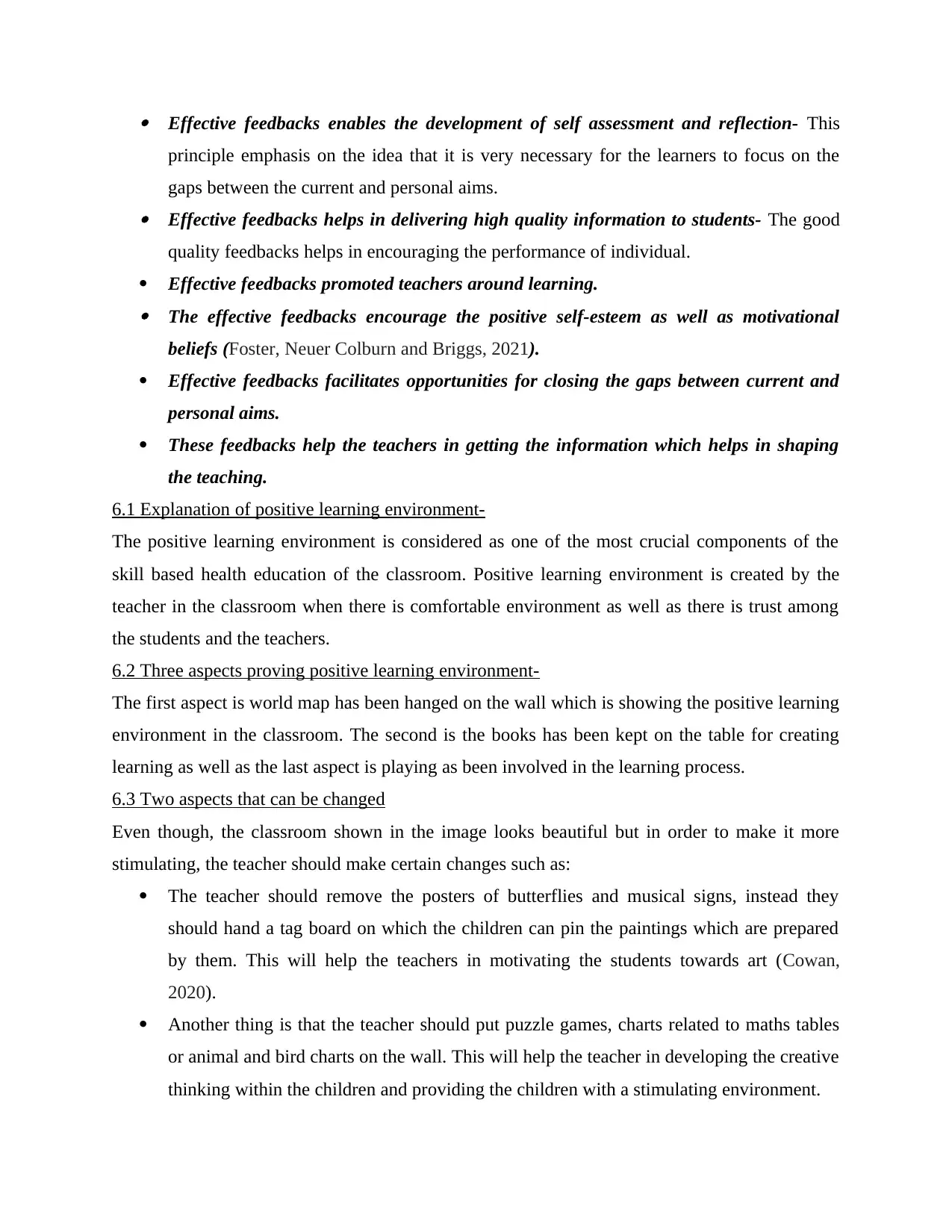
Effective feedbacks enables the development of self assessment and reflection- This
principle emphasis on the idea that it is very necessary for the learners to focus on the
gaps between the current and personal aims. Effective feedbacks helps in delivering high quality information to students- The good
quality feedbacks helps in encouraging the performance of individual.
Effective feedbacks promoted teachers around learning. The effective feedbacks encourage the positive self-esteem as well as motivational
beliefs (Foster, Neuer Colburn and Briggs, 2021).
Effective feedbacks facilitates opportunities for closing the gaps between current and
personal aims.
These feedbacks help the teachers in getting the information which helps in shaping
the teaching.
6.1 Explanation of positive learning environment-
The positive learning environment is considered as one of the most crucial components of the
skill based health education of the classroom. Positive learning environment is created by the
teacher in the classroom when there is comfortable environment as well as there is trust among
the students and the teachers.
6.2 Three aspects proving positive learning environment-
The first aspect is world map has been hanged on the wall which is showing the positive learning
environment in the classroom. The second is the books has been kept on the table for creating
learning as well as the last aspect is playing as been involved in the learning process.
6.3 Two aspects that can be changed
Even though, the classroom shown in the image looks beautiful but in order to make it more
stimulating, the teacher should make certain changes such as:
The teacher should remove the posters of butterflies and musical signs, instead they
should hand a tag board on which the children can pin the paintings which are prepared
by them. This will help the teachers in motivating the students towards art (Cowan,
2020).
Another thing is that the teacher should put puzzle games, charts related to maths tables
or animal and bird charts on the wall. This will help the teacher in developing the creative
thinking within the children and providing the children with a stimulating environment.
principle emphasis on the idea that it is very necessary for the learners to focus on the
gaps between the current and personal aims. Effective feedbacks helps in delivering high quality information to students- The good
quality feedbacks helps in encouraging the performance of individual.
Effective feedbacks promoted teachers around learning. The effective feedbacks encourage the positive self-esteem as well as motivational
beliefs (Foster, Neuer Colburn and Briggs, 2021).
Effective feedbacks facilitates opportunities for closing the gaps between current and
personal aims.
These feedbacks help the teachers in getting the information which helps in shaping
the teaching.
6.1 Explanation of positive learning environment-
The positive learning environment is considered as one of the most crucial components of the
skill based health education of the classroom. Positive learning environment is created by the
teacher in the classroom when there is comfortable environment as well as there is trust among
the students and the teachers.
6.2 Three aspects proving positive learning environment-
The first aspect is world map has been hanged on the wall which is showing the positive learning
environment in the classroom. The second is the books has been kept on the table for creating
learning as well as the last aspect is playing as been involved in the learning process.
6.3 Two aspects that can be changed
Even though, the classroom shown in the image looks beautiful but in order to make it more
stimulating, the teacher should make certain changes such as:
The teacher should remove the posters of butterflies and musical signs, instead they
should hand a tag board on which the children can pin the paintings which are prepared
by them. This will help the teachers in motivating the students towards art (Cowan,
2020).
Another thing is that the teacher should put puzzle games, charts related to maths tables
or animal and bird charts on the wall. This will help the teacher in developing the creative
thinking within the children and providing the children with a stimulating environment.
⊘ This is a preview!⊘
Do you want full access?
Subscribe today to unlock all pages.

Trusted by 1+ million students worldwide
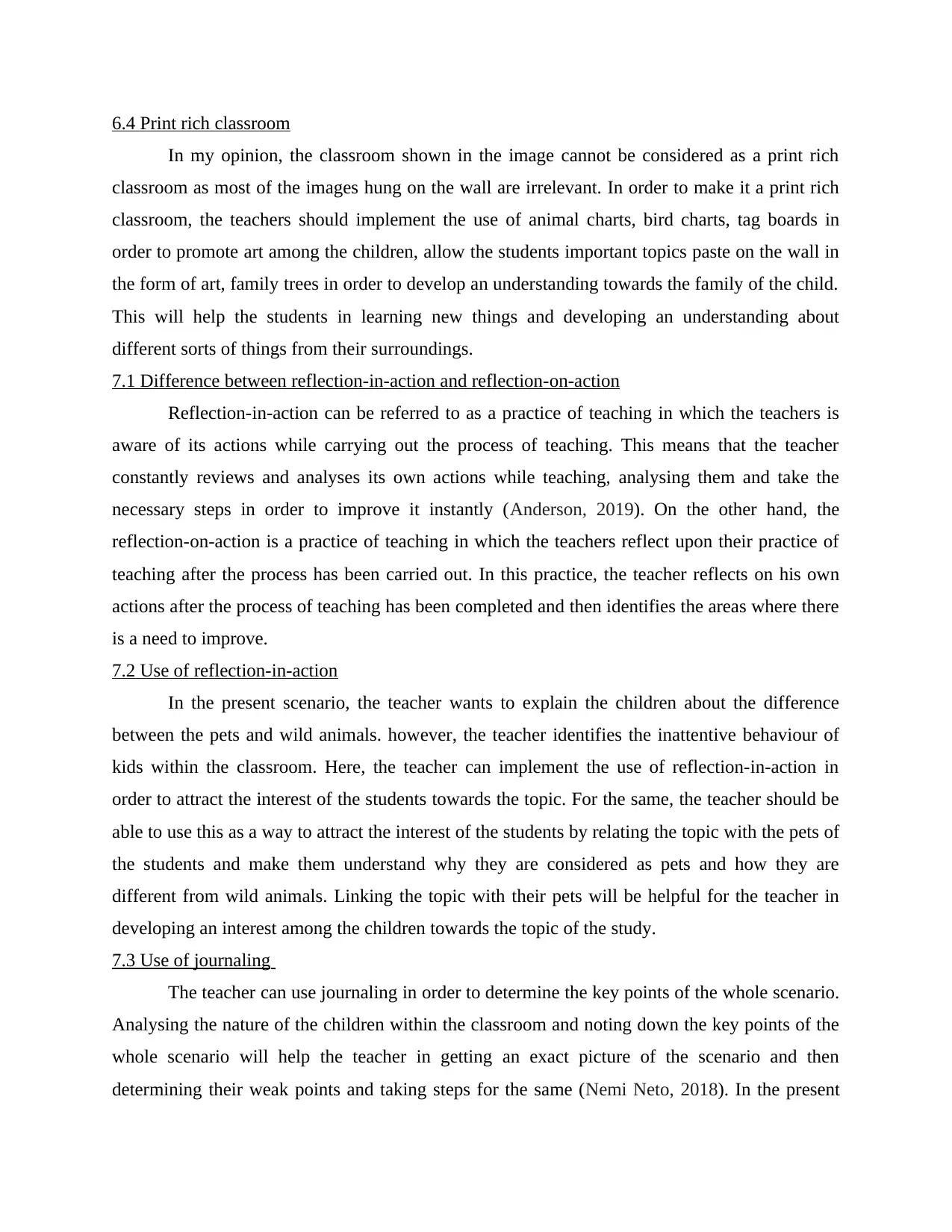
6.4 Print rich classroom
In my opinion, the classroom shown in the image cannot be considered as a print rich
classroom as most of the images hung on the wall are irrelevant. In order to make it a print rich
classroom, the teachers should implement the use of animal charts, bird charts, tag boards in
order to promote art among the children, allow the students important topics paste on the wall in
the form of art, family trees in order to develop an understanding towards the family of the child.
This will help the students in learning new things and developing an understanding about
different sorts of things from their surroundings.
7.1 Difference between reflection-in-action and reflection-on-action
Reflection-in-action can be referred to as a practice of teaching in which the teachers is
aware of its actions while carrying out the process of teaching. This means that the teacher
constantly reviews and analyses its own actions while teaching, analysing them and take the
necessary steps in order to improve it instantly (Anderson, 2019). On the other hand, the
reflection-on-action is a practice of teaching in which the teachers reflect upon their practice of
teaching after the process has been carried out. In this practice, the teacher reflects on his own
actions after the process of teaching has been completed and then identifies the areas where there
is a need to improve.
7.2 Use of reflection-in-action
In the present scenario, the teacher wants to explain the children about the difference
between the pets and wild animals. however, the teacher identifies the inattentive behaviour of
kids within the classroom. Here, the teacher can implement the use of reflection-in-action in
order to attract the interest of the students towards the topic. For the same, the teacher should be
able to use this as a way to attract the interest of the students by relating the topic with the pets of
the students and make them understand why they are considered as pets and how they are
different from wild animals. Linking the topic with their pets will be helpful for the teacher in
developing an interest among the children towards the topic of the study.
7.3 Use of journaling
The teacher can use journaling in order to determine the key points of the whole scenario.
Analysing the nature of the children within the classroom and noting down the key points of the
whole scenario will help the teacher in getting an exact picture of the scenario and then
determining their weak points and taking steps for the same (Nemi Neto, 2018). In the present
In my opinion, the classroom shown in the image cannot be considered as a print rich
classroom as most of the images hung on the wall are irrelevant. In order to make it a print rich
classroom, the teachers should implement the use of animal charts, bird charts, tag boards in
order to promote art among the children, allow the students important topics paste on the wall in
the form of art, family trees in order to develop an understanding towards the family of the child.
This will help the students in learning new things and developing an understanding about
different sorts of things from their surroundings.
7.1 Difference between reflection-in-action and reflection-on-action
Reflection-in-action can be referred to as a practice of teaching in which the teachers is
aware of its actions while carrying out the process of teaching. This means that the teacher
constantly reviews and analyses its own actions while teaching, analysing them and take the
necessary steps in order to improve it instantly (Anderson, 2019). On the other hand, the
reflection-on-action is a practice of teaching in which the teachers reflect upon their practice of
teaching after the process has been carried out. In this practice, the teacher reflects on his own
actions after the process of teaching has been completed and then identifies the areas where there
is a need to improve.
7.2 Use of reflection-in-action
In the present scenario, the teacher wants to explain the children about the difference
between the pets and wild animals. however, the teacher identifies the inattentive behaviour of
kids within the classroom. Here, the teacher can implement the use of reflection-in-action in
order to attract the interest of the students towards the topic. For the same, the teacher should be
able to use this as a way to attract the interest of the students by relating the topic with the pets of
the students and make them understand why they are considered as pets and how they are
different from wild animals. Linking the topic with their pets will be helpful for the teacher in
developing an interest among the children towards the topic of the study.
7.3 Use of journaling
The teacher can use journaling in order to determine the key points of the whole scenario.
Analysing the nature of the children within the classroom and noting down the key points of the
whole scenario will help the teacher in getting an exact picture of the scenario and then
determining their weak points and taking steps for the same (Nemi Neto, 2018). In the present
Paraphrase This Document
Need a fresh take? Get an instant paraphrase of this document with our AI Paraphraser
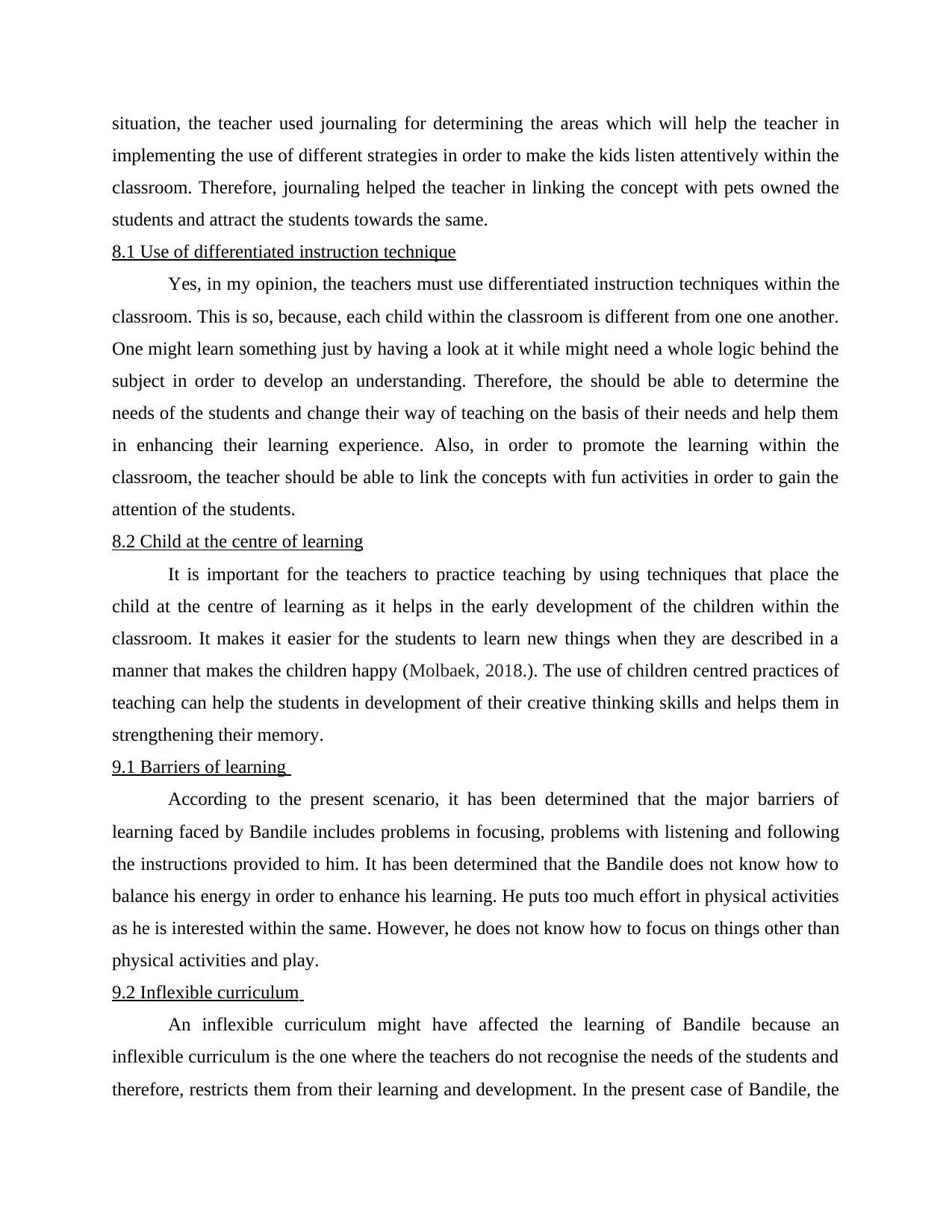
situation, the teacher used journaling for determining the areas which will help the teacher in
implementing the use of different strategies in order to make the kids listen attentively within the
classroom. Therefore, journaling helped the teacher in linking the concept with pets owned the
students and attract the students towards the same.
8.1 Use of differentiated instruction technique
Yes, in my opinion, the teachers must use differentiated instruction techniques within the
classroom. This is so, because, each child within the classroom is different from one one another.
One might learn something just by having a look at it while might need a whole logic behind the
subject in order to develop an understanding. Therefore, the should be able to determine the
needs of the students and change their way of teaching on the basis of their needs and help them
in enhancing their learning experience. Also, in order to promote the learning within the
classroom, the teacher should be able to link the concepts with fun activities in order to gain the
attention of the students.
8.2 Child at the centre of learning
It is important for the teachers to practice teaching by using techniques that place the
child at the centre of learning as it helps in the early development of the children within the
classroom. It makes it easier for the students to learn new things when they are described in a
manner that makes the children happy (Molbaek, 2018.). The use of children centred practices of
teaching can help the students in development of their creative thinking skills and helps them in
strengthening their memory.
9.1 Barriers of learning
According to the present scenario, it has been determined that the major barriers of
learning faced by Bandile includes problems in focusing, problems with listening and following
the instructions provided to him. It has been determined that the Bandile does not know how to
balance his energy in order to enhance his learning. He puts too much effort in physical activities
as he is interested within the same. However, he does not know how to focus on things other than
physical activities and play.
9.2 Inflexible curriculum
An inflexible curriculum might have affected the learning of Bandile because an
inflexible curriculum is the one where the teachers do not recognise the needs of the students and
therefore, restricts them from their learning and development. In the present case of Bandile, the
implementing the use of different strategies in order to make the kids listen attentively within the
classroom. Therefore, journaling helped the teacher in linking the concept with pets owned the
students and attract the students towards the same.
8.1 Use of differentiated instruction technique
Yes, in my opinion, the teachers must use differentiated instruction techniques within the
classroom. This is so, because, each child within the classroom is different from one one another.
One might learn something just by having a look at it while might need a whole logic behind the
subject in order to develop an understanding. Therefore, the should be able to determine the
needs of the students and change their way of teaching on the basis of their needs and help them
in enhancing their learning experience. Also, in order to promote the learning within the
classroom, the teacher should be able to link the concepts with fun activities in order to gain the
attention of the students.
8.2 Child at the centre of learning
It is important for the teachers to practice teaching by using techniques that place the
child at the centre of learning as it helps in the early development of the children within the
classroom. It makes it easier for the students to learn new things when they are described in a
manner that makes the children happy (Molbaek, 2018.). The use of children centred practices of
teaching can help the students in development of their creative thinking skills and helps them in
strengthening their memory.
9.1 Barriers of learning
According to the present scenario, it has been determined that the major barriers of
learning faced by Bandile includes problems in focusing, problems with listening and following
the instructions provided to him. It has been determined that the Bandile does not know how to
balance his energy in order to enhance his learning. He puts too much effort in physical activities
as he is interested within the same. However, he does not know how to focus on things other than
physical activities and play.
9.2 Inflexible curriculum
An inflexible curriculum might have affected the learning of Bandile because an
inflexible curriculum is the one where the teachers do not recognise the needs of the students and
therefore, restricts them from their learning and development. In the present case of Bandile, the
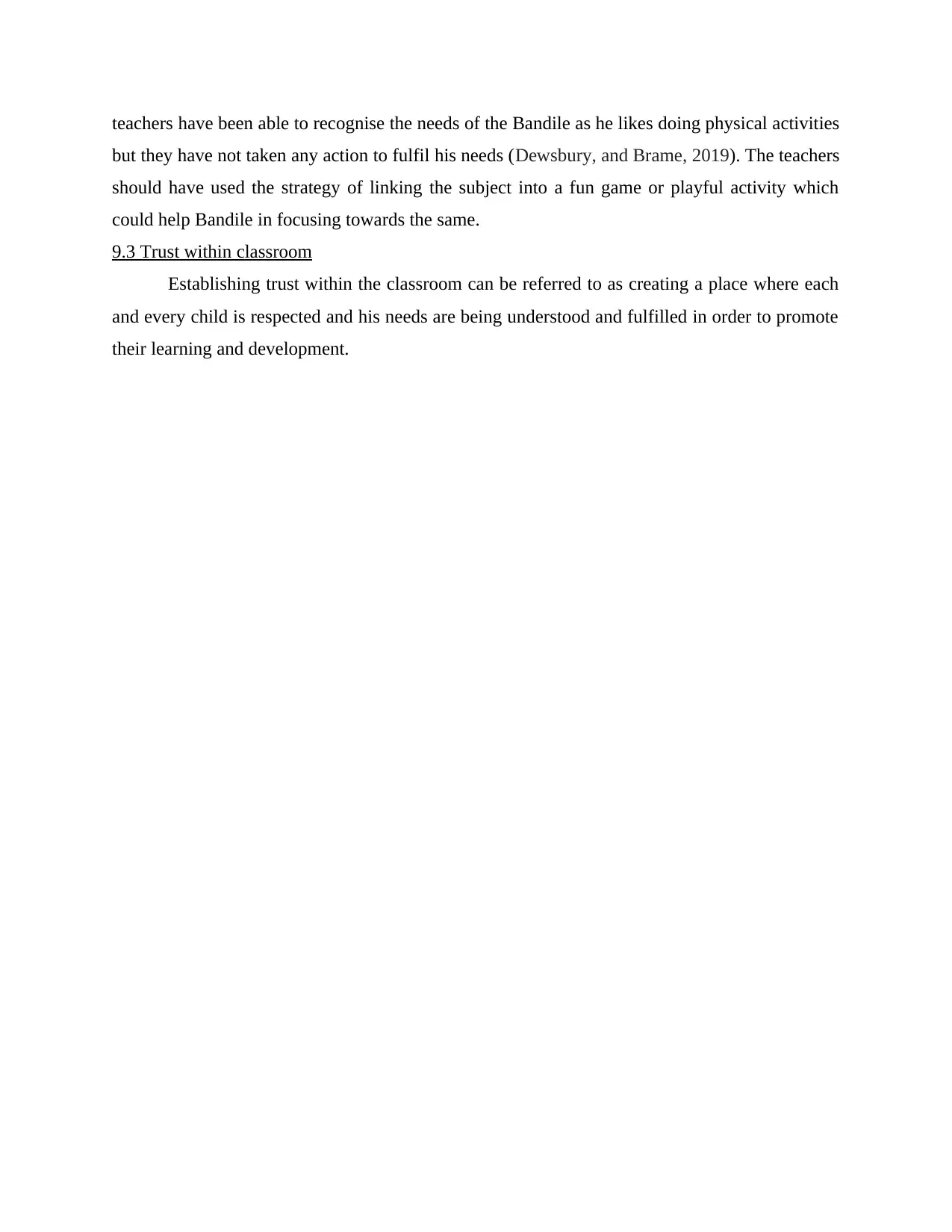
teachers have been able to recognise the needs of the Bandile as he likes doing physical activities
but they have not taken any action to fulfil his needs (Dewsbury, and Brame, 2019). The teachers
should have used the strategy of linking the subject into a fun game or playful activity which
could help Bandile in focusing towards the same.
9.3 Trust within classroom
Establishing trust within the classroom can be referred to as creating a place where each
and every child is respected and his needs are being understood and fulfilled in order to promote
their learning and development.
but they have not taken any action to fulfil his needs (Dewsbury, and Brame, 2019). The teachers
should have used the strategy of linking the subject into a fun game or playful activity which
could help Bandile in focusing towards the same.
9.3 Trust within classroom
Establishing trust within the classroom can be referred to as creating a place where each
and every child is respected and his needs are being understood and fulfilled in order to promote
their learning and development.
⊘ This is a preview!⊘
Do you want full access?
Subscribe today to unlock all pages.

Trusted by 1+ million students worldwide
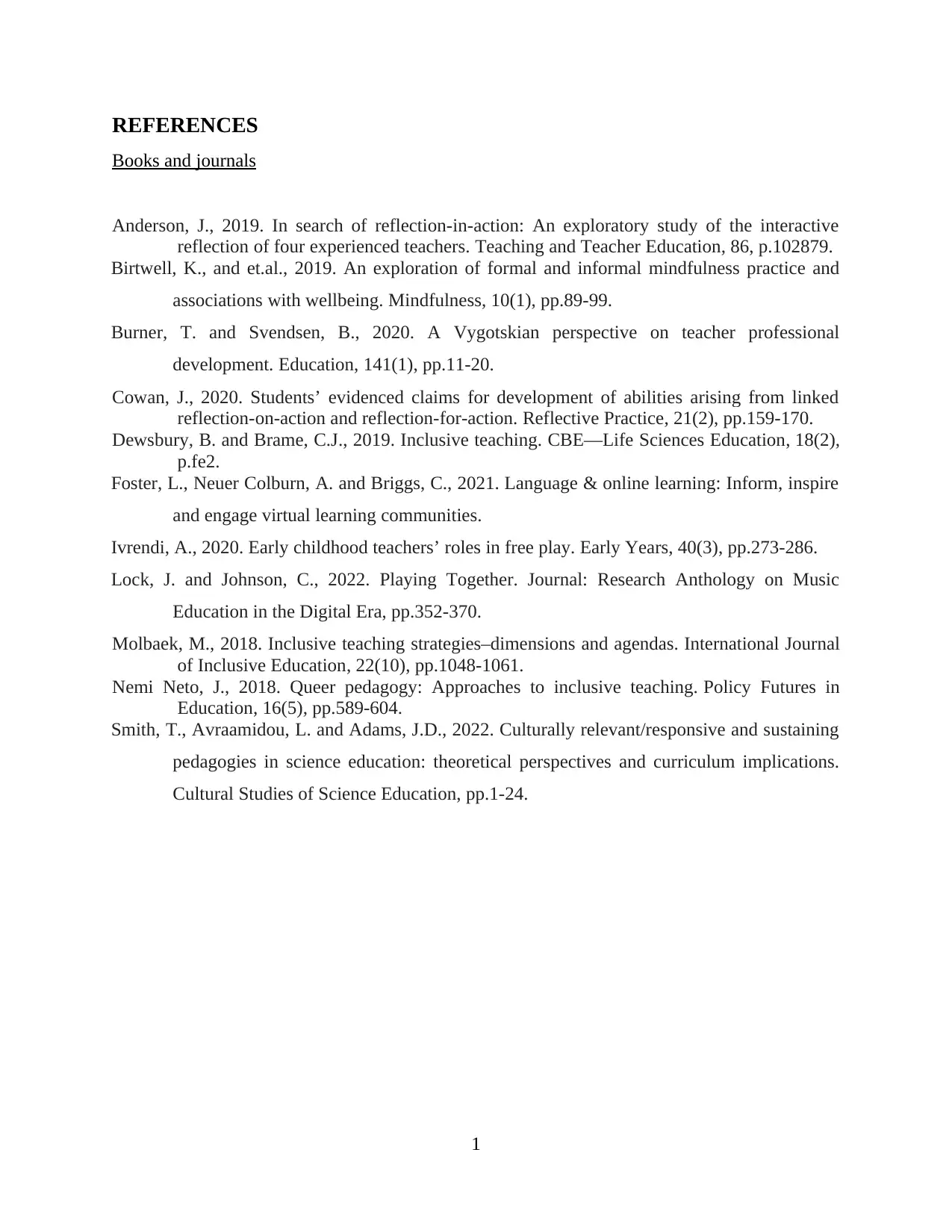
REFERENCES
Books and journals
Anderson, J., 2019. In search of reflection-in-action: An exploratory study of the interactive
reflection of four experienced teachers. Teaching and Teacher Education, 86, p.102879.
Birtwell, K., and et.al., 2019. An exploration of formal and informal mindfulness practice and
associations with wellbeing. Mindfulness, 10(1), pp.89-99.
Burner, T. and Svendsen, B., 2020. A Vygotskian perspective on teacher professional
development. Education, 141(1), pp.11-20.
Cowan, J., 2020. Students’ evidenced claims for development of abilities arising from linked
reflection-on-action and reflection-for-action. Reflective Practice, 21(2), pp.159-170.
Dewsbury, B. and Brame, C.J., 2019. Inclusive teaching. CBE—Life Sciences Education, 18(2),
p.fe2.
Foster, L., Neuer Colburn, A. and Briggs, C., 2021. Language & online learning: Inform, inspire
and engage virtual learning communities.
Ivrendi, A., 2020. Early childhood teachers’ roles in free play. Early Years, 40(3), pp.273-286.
Lock, J. and Johnson, C., 2022. Playing Together. Journal: Research Anthology on Music
Education in the Digital Era, pp.352-370.
Molbaek, M., 2018. Inclusive teaching strategies–dimensions and agendas. International Journal
of Inclusive Education, 22(10), pp.1048-1061.
Nemi Neto, J., 2018. Queer pedagogy: Approaches to inclusive teaching. Policy Futures in
Education, 16(5), pp.589-604.
Smith, T., Avraamidou, L. and Adams, J.D., 2022. Culturally relevant/responsive and sustaining
pedagogies in science education: theoretical perspectives and curriculum implications.
Cultural Studies of Science Education, pp.1-24.
1
Books and journals
Anderson, J., 2019. In search of reflection-in-action: An exploratory study of the interactive
reflection of four experienced teachers. Teaching and Teacher Education, 86, p.102879.
Birtwell, K., and et.al., 2019. An exploration of formal and informal mindfulness practice and
associations with wellbeing. Mindfulness, 10(1), pp.89-99.
Burner, T. and Svendsen, B., 2020. A Vygotskian perspective on teacher professional
development. Education, 141(1), pp.11-20.
Cowan, J., 2020. Students’ evidenced claims for development of abilities arising from linked
reflection-on-action and reflection-for-action. Reflective Practice, 21(2), pp.159-170.
Dewsbury, B. and Brame, C.J., 2019. Inclusive teaching. CBE—Life Sciences Education, 18(2),
p.fe2.
Foster, L., Neuer Colburn, A. and Briggs, C., 2021. Language & online learning: Inform, inspire
and engage virtual learning communities.
Ivrendi, A., 2020. Early childhood teachers’ roles in free play. Early Years, 40(3), pp.273-286.
Lock, J. and Johnson, C., 2022. Playing Together. Journal: Research Anthology on Music
Education in the Digital Era, pp.352-370.
Molbaek, M., 2018. Inclusive teaching strategies–dimensions and agendas. International Journal
of Inclusive Education, 22(10), pp.1048-1061.
Nemi Neto, J., 2018. Queer pedagogy: Approaches to inclusive teaching. Policy Futures in
Education, 16(5), pp.589-604.
Smith, T., Avraamidou, L. and Adams, J.D., 2022. Culturally relevant/responsive and sustaining
pedagogies in science education: theoretical perspectives and curriculum implications.
Cultural Studies of Science Education, pp.1-24.
1
Paraphrase This Document
Need a fresh take? Get an instant paraphrase of this document with our AI Paraphraser

2
1 out of 11
Related Documents
Your All-in-One AI-Powered Toolkit for Academic Success.
+13062052269
info@desklib.com
Available 24*7 on WhatsApp / Email
![[object Object]](/_next/static/media/star-bottom.7253800d.svg)
Unlock your academic potential
Copyright © 2020–2025 A2Z Services. All Rights Reserved. Developed and managed by ZUCOL.





